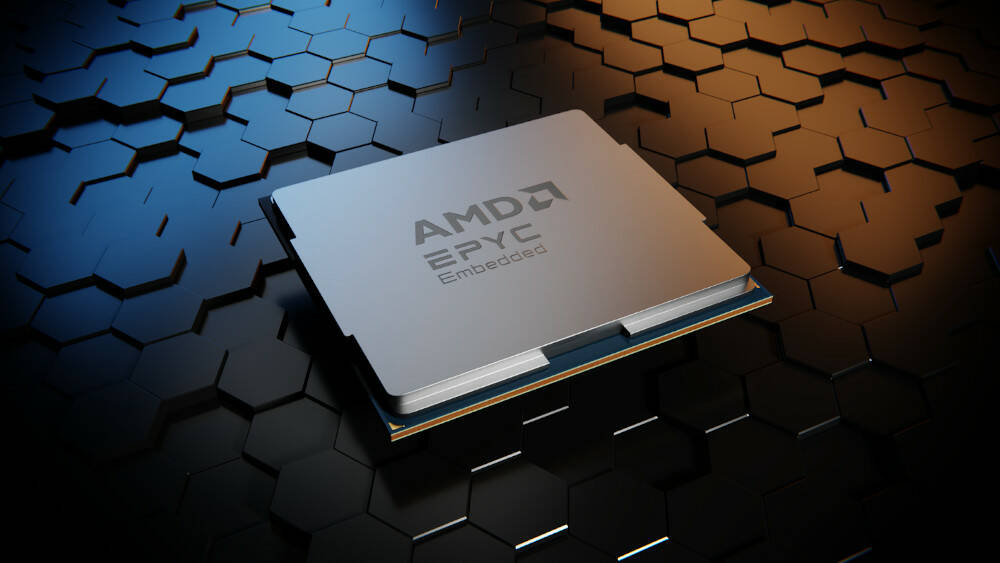Industrial Design: AMD Brings 4th Gen Epyc Power To Embedded Applications

AMD has lifted the lid on variants of its 4th generation Epyc processors optimized for embedded applications, delivering greater performance and scalability – although device engineers may look askance at the power envelope ranging up to 400W.
Announced at Embedded World in Nuremberg, Germany, the Epyc Embedded 9004 Series consists of 10 processor models with 16 up to 96 cores in single-socket and dual-socket versions, designed to meet the performance and efficiency requirements of applications such as networking, security/firewall devices, storage and industrial systems, AMD says.
Although the chipmaker reckons it is bringing "world-class performance and energy efficiency" to embedded systems, the Epyc Embedded 9004 Series appears to have a thermal design power (TDP) profile of 200W up to 400W for the top-end chips, which is in line with that of the chipmaker's mainstream 4th gen Epyc family, which launched late last year.
However, engineers will be more pleased by the seven-year planned availability for the chips, given that embedded chips tend to be used in hardware and appliances that will be around for longer than the average PC or server lifecycle.
AMD also claims a number of embedded-specific features for the Epyc Embedded 9004 Series. Among these is Non-Transparent Bridging (NTB), a redundancy capability which allows two CPUs to access each other’s memory and I/O via a bridge linking their respective PCIe buses.
Another is support for non-volatile DIMMs (NVDIMMs), memory modules that combine DRAM and flash such that the memory content is saved to flash in the event of a power failure.
Also supported are dual Serial Peripheral Interface (SPI) ports for secure boot via external ROMs. The first ROM contains the BIOS image, while the second will contain a proprietary bootloader from the customer to validate and load the BIOS image, AMD said.
The chipmaker lists several reliability, availability and serviceability (RAS) capabilities implemented in the new embedded portfolio, such as support for ECC memory using AMD’s own Advanced Memory Device Correction (AMDC); PCIe System Firmware Intermediary (SFI) capability to isolate hot plug events from the OS and applications; and post-package repair (PPR) capability to identify a failed memory row or location and substitute a spare row instead, intended to reduce the need for DIMMs to be replaced while a device is in service.
In other respects, the Epyc Embedded 9004 Series is similar to the mainstream Epyc datacenter chips, if not completely identical; up to 96 Zen 4 cores, 12 channels of DDR5 4800 memory, and up to 128 PCIe 5.0 lanes for I/O.
“With the launch of the EPYC Embedded 9004 Series processors, we’re bringing the power of datacenter-level computing to embedded networking, security, storage and industrial applications,” said the corporate vice president and general manager of AMD’s Embedded Solutions Group, Rajneesh Gaur.
- AMD flips the bird at Intel as it glides past in CPU-GPU stakes
- While Intel XPUs are delayed, here's some more FPGAs to tide you over
- Microsoft opens Azure confidential containers to public preview
- Unless things change, first zettaflop systems will need nuclear power, AMD's Su says
One customer AMD already has lined up for the new embedded chips is industrial giant Siemens, which is using the Epyc Embedded 9004 Series in its SIMATIC IPC RS-828A server designed for applications such as automotive manufacturing, 5G base stations and IoT.
A Siemens spokesperson said in a statement that had chosen the new AMD chips for the ability to deliver speeds and power efficiency while operating in extreme temperatures, as well as in settings with vibration or electromagnetic interference. The new processors will "open new opportunities for the industrial market," it added.
The AMD EPYC Embedded 9004 Series processors are sampling to customers now with production shipments expected in April. ®
From Chip War To Cloud War: The Next Frontier In Global Tech Competition
The global chip war, characterized by intense competition among nations and corporations for supremacy in semiconductor ... Read more
The High Stakes Of Tech Regulation: Security Risks And Market Dynamics
The influence of tech giants in the global economy continues to grow, raising crucial questions about how to balance sec... Read more
The Tyranny Of Instagram Interiors: Why It's Time To Break Free From Algorithm-Driven Aesthetics
Instagram has become a dominant force in shaping interior design trends, offering a seemingly endless stream of inspirat... Read more
The Data Crunch In AI: Strategies For Sustainability
Exploring solutions to the imminent exhaustion of internet data for AI training.As the artificial intelligence (AI) indu... Read more
Google Abandons Four-Year Effort To Remove Cookies From Chrome Browser
After four years of dedicated effort, Google has decided to abandon its plan to remove third-party cookies from its Chro... Read more
LinkedIn Embraces AI And Gamification To Drive User Engagement And Revenue
In an effort to tackle slowing revenue growth and enhance user engagement, LinkedIn is turning to artificial intelligenc... Read more

